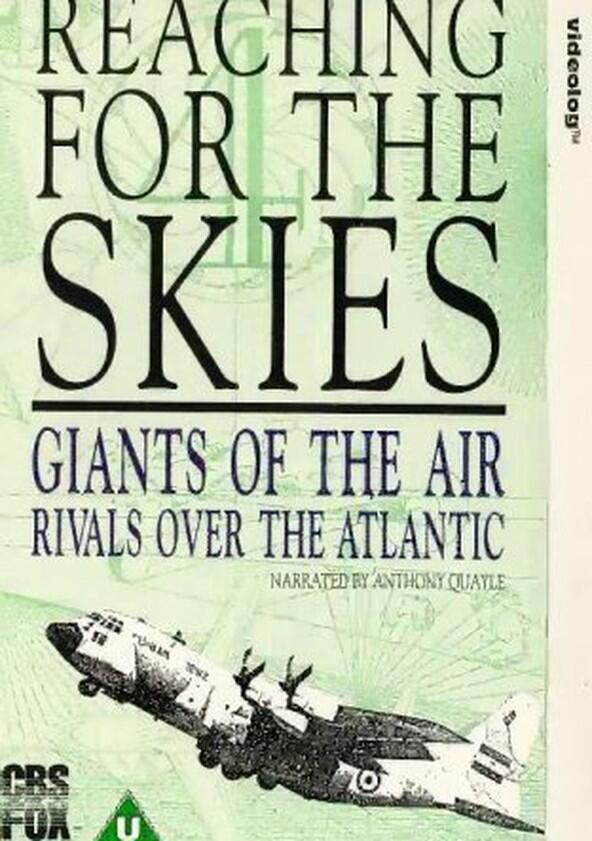Reaching for the Skies - Season 1

Season 1

Episodes

The Pioneers
This programme tells the story of aviation pioneers, both men and machines, with specially shot sequences, interviews with people involved and archive film not seen before on television.

The Aeroplane Goes to War
Shortly after man first achieved powered flight, his new invention was harnessed for battle. The First World War was to be a catalyst for the development of the aeroplane. It added a whole new dimension to warfare - air power.

Trailblazers
Flying between countries and continents is an accepted way of life to millions of people. But as their airliners cruise along at hundreds of miles an hour, tens of thousands of feet above the earth, how many spare a thought for those early pioneers?

Lighter Than Air
Paris, November 1783: an awe-struck crowd in the Bois de Boulogne watched as a balloon built by Joseph and Etienne Montgolfier rose into the sky.
Later, magnificent airships, became luxurious liners of the skies. But the disasters of the R101 and the Hindenburg brought this chapter to a fiery end.

Bombers
On 6 August 1945, a B29 bomber, called Enola Gay after the captain's mother, dropped an atomic bomb on the Japanese city of Hiroshima. Seventy-eight thousand people died immediately. It was the ultimate in terror bombing. An aeroplane first dropped a bomb just eight years after the Wright brothers first flew. A new and horrific dimension to warfare had arrived. Conventional bombing reached its climax in the Vietnam War, when the United States, in a ten-year-long campaign dropped six-and-a-half million tons of bombs. More than was used in the whole of the Second World War.

Quest for Speed
In 1909 Glenn Curtiss took his wood and fabric Pusher bi-plane to Rheims for the world's first air races.
Louis Bleriot started as favourite, but Curtiss took the trophy at a record 461 miles an hour. Soon fans on both sides of the Atlantic were flocking to race meets. Fierce international rivalry built up to produce the fastest flying machines in the world. The RAF Spitfire was a direct descendant of racing planes. In Hitler's Germany, scientists produced revolutionary rocket and jet-powered fighters - the fastest of the war. Less than 40 years after Curtiss set his record, man broke through the sound barrier.

Giants of the Air
From the moment man first took to the skies, the dream has been to build bigger and bigger aircraft. The early designers saw the advantages that large aeroplanes would bring as passenger and cargo carriers. The military also needed them to carry troops and drop bombs. The problem in the early days was the lack of engine power. It was the invention of the jet engine that finally provided the answer to the designers' dreams. A new generation of huge aircraft were born - planes like the C5 Galaxy which is capable of carrying more than a 100 cars.

Rivals Over the Atlantic
Of all the air routes in the world, none have been more fiercely contested than those between Europe and the United States. The invention of the jet engine was to signal the start of the second battle of the Atlantic - the combatants were the giant aircraft manufacturers and airline operators - De
Havilland and Boeing, BOAC and Pan Am. As the airline passenger market grew in the 60s and 70s, Boeing emerged the clear leader. Europe's gamble on speed with Concorde had failed - size and economy had won. The 747 Jumbo jet was the king of the airliners.

Fighters
One aircraft above all others demonstrates man's mastery of the skies - the fighter. The men who fly them, an elite among pilots. From the Second World War to Korea, the Middle East and Vietnam, the fighter's role has remained the same. A unique partnership between man and machine, designed to seek out and destroy the enemy.

Vertical Flight
The problem of designing a machine capable of taking off and landing vertically was perhaps the greatest challenge faced by the early aviation pioneers. When the Germans and then the Russian emigre,
Igor Sikorsky finally solved the complicated physics involved, the world quickly benefited from an ultimately flexible aircraft - the helicopter. The military were quick to realise its potential, indeed the Americans fought a war with it - Vietnam. With the advent of the jet engine though, came a new breed of vertical take-off aircraft. One was to outlast, outperform and outmanoeuvre all its rivals - the Harrier jump jet. As airport congestion grows, vertical-flight aircraft will be a vital part of the future of aviation.

Victory Over the Sea
Early in the Second World War, aircraft began to wrest the traditional control of the sea from the battleship.
Flimsy Swordfish biplanes, launched from Royal Navy aircraft carriers, flew daring torpedo raids which crippled the Italian fleet at Taranto and the giant German battleship, Bismarck. In the Pacific, American and Japanese carrier-borne aircraft attacked each other's fleets. A new warfare had developed. British innovations like the angle-deck allowed faster, heavier jet aircraft to land at sea, leading to the giant American super-carriers of today.

The Adventure of Flight
Why do people fly? What is it about flight that has fascinated man for centuries? Pilots speak of it as a privilege. There's a common bond among them all. A dedication to excellence.
Some have called it the 'right stuff, others 'the touch', all talk of 'the freedom'. Richard Bach , former test pilot and author of Jonathan Livingstone Seagull captures the essence of this adventure of flight.
Recently Updated Shows

The Snake
The Snake will follow 15 people from various professions trying to manipulate their way to becoming that week's snake, who decides who stays and who leaves the show, through a series of challenges. Each week, the winner of each challenge earns control of ‘The Saving Ceremony', an elimination that is about who will save certain contestants with people making friends, faking friends, or sparking romantic connections with the winner taking home $100,000.

The 1% Club
The 1% Club is a unique, compelling and funny entertainment show that tests the nation's intelligence, based on a scientific survey. It's a chance to test how your brain works through a series of questions that all have a right answer but can also lead to a series of entertaining wrong answers along the way. Whether you're a contestant vying for the cash prize or a viewer playing with your friends and family on the app, answer enough questions correctly, and you could earn yourself a place in the 1% Club: an elite group of people who can honestly say they've outwitted 99% of the population.

The Daily Show
Hosted by a rotating cast of comedy greats, The Daily Show remains the go-to source for provocative satire, insightful interviews and an award-winning team of correspondents and contributors.

Mama June: From Not to Hot
Mama June: From Not to Hot is all about Mama June's dramatic transformation. "I'm a mama, a grandmama, and a BIG reality star — and now I'm ready for a BIG change," Mama June narrates as we see her strike various poses. But she's not just talking about physical changes, she's revamping her entire life! "It's time to say goodbye to bad men and junk food," Mama June says before adding that fans (and haters) can all "[say] hello to a whole new me, because when they see what I look like now, they're not going to believe their eyes!" At this point we see a string of text that I assume are all things that went into Mama June's dramatic makeover. Included in the list are weight loss surgery, physical therapy, liquid diet, tummy tuck, gastric sleeve, strength training, breast implants, high intensity training, and laser teeth whitening.
